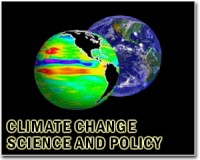| . |  |
. |
Paris (AFP) Sept 1, 2010 Climate change could reduce key harvests in China by a fifth if the gloomiest scenarios prove true, according to a study on Wednesday. Publishing in the journal Nature, a team of Chinese scientists say China's climate "has clearly warmed" over the past half century, gaining 1.2 degrees Celsius (2.2 degrees Fahrenheit) since 1960. The hotspots were northeastern China with a warming trend of 0.36 C (0.65 F) per decade, and Inner Mongolia, with a warming of 0.4 C (0.7 F) per decade. Nationally, heatwaves have become more common, the number of cold days has fallen sharply and glaciers that are vital river feeders are in retreat, they say. The last century was the warmest period since 1600 and the country's seven warmest years have all occurred in the past decade. Climate extremes included droughts which hit the country in the 1960s, the late 1970s, early 1980s, the 1990s and in northeastern China in the last decade. In 1998, floods inundated 21 million hectares (52.5 million acres) of land, destroyed five million homes in the Yangtze basin and inflicted 20 billion dollars in damage. Floods this year affected 230 million people, of whom more than 15 million had to be evacuated from their homes, and left more than 4,200 people dead or missing, according to a toll issued on Tuesday. The paper, lead-authored by Peking University environmental scientist Shilong Piao, warns of problems for China's racing economy in coming decades if climate change bites hard. Accurate prediction, though, is hard, it says. "China experienced explosive economic growth in recent decades, but with only seven percent of the world's arable land available to feed 20 percent of the world's population, China's economy may be vulnerable to climate change itself," it warns. The biggest problem could be water stress, amplified by a growing and increasingly wealthy population. Water is abundant in southern China but sparse in the country's north, and overall China's per capita water availability is only 25 percent of the world average. "Many regions lie in transitional zones where water resources, and hence agricultural production, could be affected positively or negatively by changes in climate," the study says. In the most favourable scenario, grain yields by mid-century could remain stable or benefit from the rise in carbon dioxide levels. But in the worst scenario, there could be declines of four to 14 percent for rice, between two and 20 percent for wheat and between zero and 23 percent for corn in cases where these crops are rainfed rather than irrigated. The comparison is the yields of these crops between 1996 and 2000. Any future improvements in agro-technology in coming decades are not factored in. "The range of model results is large, implying large uncertainties," cautions the paper. The many unknowns are reflected by the wide range in predicting warming for China as a whole -- from 1 C to 5 C (1.8-9.0 F) by 2100, depending on worldwide emissions of greenhouse gases. Computer simulations for climate impacts have advanced substantially for modelling what will happen worldwide, but lag when it comes to predicting regional effects, especially on rainfall, the paper says. "To reach a more definitive conclusion, future work must... develop a better understanding of the managed and unmanaged responses to crops to changes in climate, diseases, pests and atmospheric constituents."
Share This Article With Planet Earth
Related Links Climate Science News - Modeling, Mitigation Adaptation
 Rajendra Pachauri: IPCC chief in the spotlight
Rajendra Pachauri: IPCC chief in the spotlightNew Delhi (AFP) Aug 31, 2010 Rajendra Pachauri, under harsh scrutiny as head of the UN's top advisory body on climate change, is a 69-year-old Nobel Peace Prize winner with a sideline in writing steamy novels. The Indian said late Monday that member nations of the Intergovernmental Panel on Climate Change (IPCC) would have to decide his fate after a damning UN-ordered review into the body's research. But Pachauri, a ... read more |
|
| The content herein, unless otherwise known to be public domain, are Copyright 1995-2010 - SpaceDaily. AFP and UPI Wire Stories are copyright Agence France-Presse and United Press International. ESA Portal Reports are copyright European Space Agency. All NASA sourced material is public domain. Additional copyrights may apply in whole or part to other bona fide parties. Advertising does not imply endorsement,agreement or approval of any opinions, statements or information provided by SpaceDaily on any Web page published or hosted by SpaceDaily. Privacy Statement |